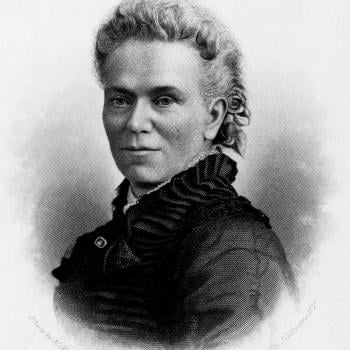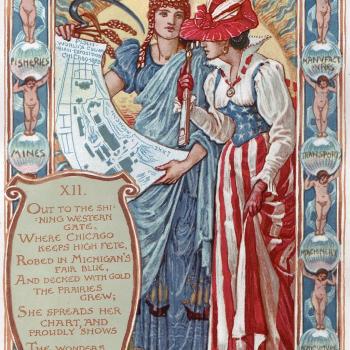On Monday, I described Paul Matzko’s important new book, The Radio Right: How a Band of Broadcasters Took on the Federal Government and Built the Modern Conservative Movement. Paul described how far Right broadcasters like Billy James Hargis and Carl McIntire gained a mass following for their message, alarming both the Kennedy White House and the liberal mainline churches. In this guest post, Paul describes how the NCC responded to this alarming threat.
When the National Council of Churches Went to War by Paul Matzko
By the early 1960s, the leadership of the National Council of Churches realized that they had a radio problem. Letters were pouring in from clergy all over the country, letters that complained of parishioners regurgitating wild conspiracy theories they heard on the radio about Communist infiltration of the major Protestant denominations. In the words of one flustered clergyman, conservative radio broadcasters were “poisoning the minds of our people who will believe anything if told often enough.” Parishioners, after all, only heard their pastor preach a sermon one day a week; but they could tune their radios to hear conservative programming every single day of the week for hours at a stretch.
This was historically unprecedented. In the 1930s and 40s, even the most successful conservative radio broadcasters were typically relegated to an isolated time-slot on network radio or they perhaps owned a single radio station. But by the early 1960s, a dozen conservative radio broadcasters aired on 100 stations nationwide. Suddenly a majority of Americans could listen to conservative radio all day, every day.
The top conservative broadcasters each had strong religious ties; the most prominent was the Rev. Carl McIntire, who, despite leading a tiny fundamentalist denomination, had a radio show, The Twentieth Century Reformation Hour, which aired on over 400 radio stations nationwide and had an estimated weekly listening audience of 20 million. For sake of comparison, that is as many people in absolute terms as would listen to Rush Limbaugh at his peak a generation later (and bigger in relative terms given that the national population was at least half again as large).
Yet historians of the period have minimized the significance of fundamentalists like McIntire given how few people were in their denominations. What is, after all, the Bible Presbyterian Church’s 6,000 members stacked up against the 45 million constituents of the Nation Council of Churches? But new media forms create new modes of influence not adequately captured by institutional membership. Consider how different the picture looks when we shift our focus from church membership data to success with fundraising. In the mid-60s, the radio arm of the National Council of Churches, the Broadcasting and Film Commission, had a respectable annual income of $250,000; on the other hand, Carl McIntire, alone, averaged over $2 million in small-dollar listener donations per year.
But perhaps the best assessment of the threat posed by the Radio Right to mainline Protestants came from the National Council of Churches itself, proven by its willingness to fight back and fight dirty. National Council vice president Bishop John Wesley Lord wanted to commission “shock troops to meet the attacks of the virus,” the virus being conservative broadcasters. At first, however, there was little the National Council could do other than to support educational counter-programming.
The situation changed after 1963 when the Federal Communications Commission, the government agency responsible for licensing radio stations, expanded a set of regulations known as the Fairness Doctrine. The Fairness Doctrine was meant to encourage stations to air multiple points of view on “controversial matters of public importance”; they should, in other words, create ideological and partisan balance in their coverage of current events. Also, if they aired a “personal attack,” the target of the attack should be given the right to reply, potentially without having to pay for the airtime. Those who felt that a station fell short of these responsibilities could file a complaint with the FCC, which the agency would take into consideration at the station’s next license renewal hearing. Merely the threat of a Fairness Doctrine complaint was often enough to extract concessions from station owners.
The John F. Kennedy administration had its own reasons for reviving the Fairness Doctrine—which is the primary focus of my forthcoming book—but it also provided the National Council of Churches with a golden opportunity to push back against the rise of Right-wing religious radio. They might have failed to win in the marketplace of public opinion, but they could now try and eradicate the “virus” using public power.
In 1966 the National Council organized a national letter-writing campaign that threatened Fairness Doctrine complaints against hundreds of stations airing conservative programming. The proximate goal was to convince stations to air, for free, a series of National Council-approved programs discussing the threat of the Radio Right to the country; but the ultimate goal was to encourage stations to drop conservative programming altogether in order to avoid the additional expense or a potential headache at license renewal time.
That campaign overlapped with an investigation by US Senate Democrats into the Radio Right. Indeed, the Senate Commerce Committee’s lead investigator, Bob Lowe, coordinated his efforts with the National Council’s Broadcasting and Film Commission, relied on the commission to supply him with a list of stations airing conservative programs, and leaked privileged information about the FCC’s plans for future rule changes that could help in the counter-Radio Right effort.
Their collaboration bore fruit in 1967 when Lowe issued a report showing that stations had started dropping conservative broadcasters en masse. The average conservative radio program had lost a third of its host stations in less than a year; but religious broadcasters, including McIntire, who had also been targeted by the National Council of Churches saw a 59% decline, nearly double the rate of secular programs. As a result, Carl McIntire’s Twentieth Century Reformation Hour entered a financial tailspin.
By the early 1970s, all the major conservative broadcasters were reduced to airing on only a few dozen stations each. It was not until after the Carter and Reagan administrations relaxed the FCC’s Fairness Doctrine rules that a second wave of Right-wing religious radio would return with broadcasters like Jerry Falwell and Pat Robertson.
It is no accident that the mainline Protestant denominations began their statistical decline in the mid-1960s. There was a sharp ideological divide between Council-affiliated clergy, who skewed liberal both in theology and politics, and its more conservative laity, a divide exploited by the Radio Right. The National Council opted to respond with censorship rather than persuasion, but muting conservative broadcasters only delayed the coming reckoning.
Today, the tables are turned. Conservative Protestant clergy are confronted with the fact that they have less influence over the worldview of their congregants than they had thought. After all, congregants only hear from the pulpit once or twice a week; but they can go home and watch Fox News or listen to talk radio all day, every day. As with radio in the 1960s, so too with cable news and social media half a century later; a new media form has created new modes of influence and allowed previously marginalized points of view to return to the mainstream. As Fred Clark has argued, that means the “Weird Fringe” of evangelicalism has returned to the center of the movement.
And today, like in the 1960s, the divide between evangelical clergy and laity is widening. Traditional evangelical gatekeepers have been left aghast at the rise of ethno-nationalist populism in their own denominations, as when Russell Moore, president of the Southern Baptist Convention’s Ethics and Religious Liberty Commission, was confronted by Islamophobic dissent at the Convention’s annual meeting in 2016. It’s not hard to imagine someone like Moore complaining privately that the conservative media ecosystem was “poisoning the minds of our people who will believe anything if told often enough.”













